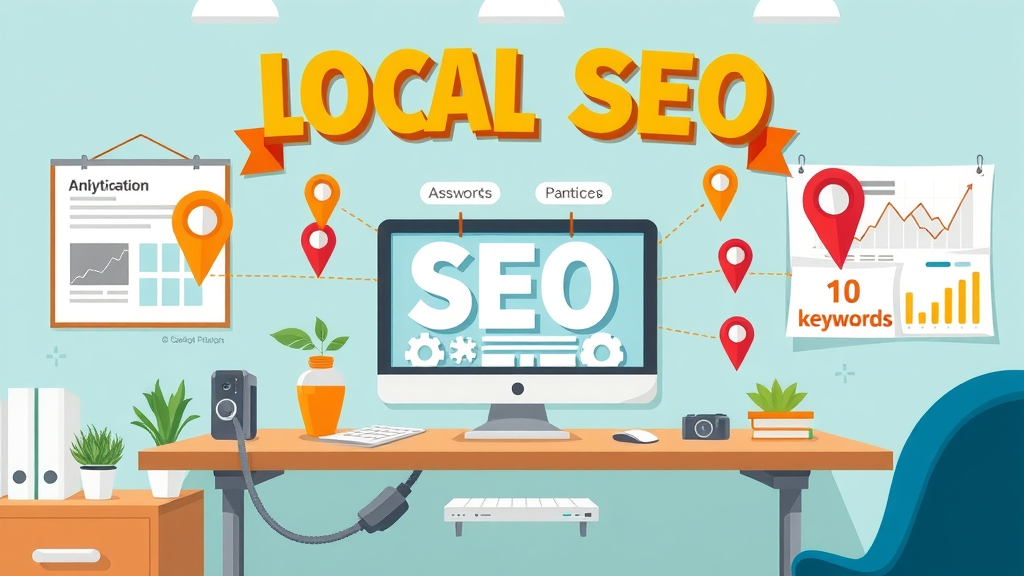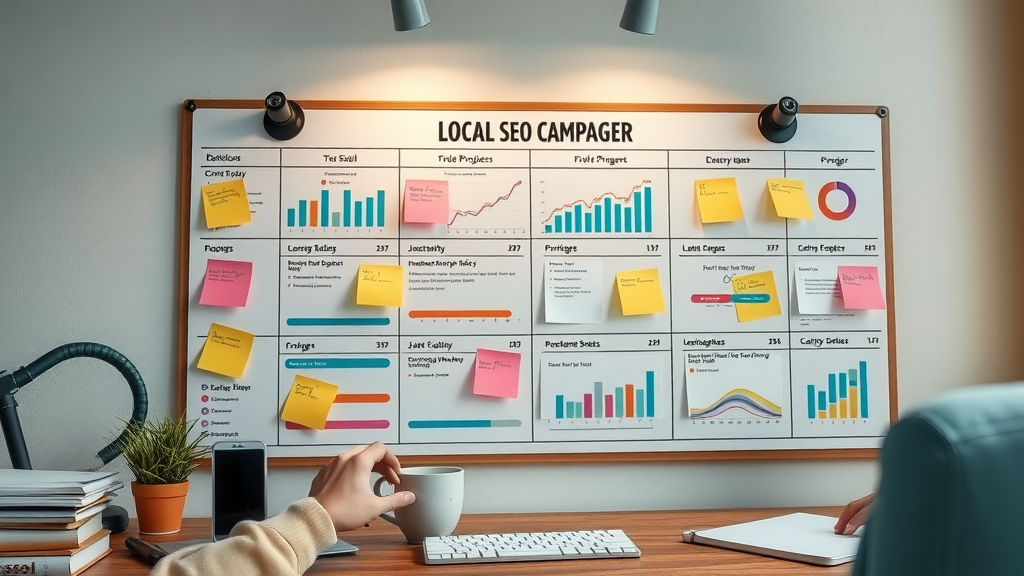Did you know: 46% of all Google searches are seeking local information ? If your business isn’t optimized for local search, you’re invisible to nearly half your potential customers. Whether you’re a new café, a family-run service, or a retail shop looking to compete on your block, mastering SEO for local business websites is no longer optional—it’s essential. In this in-depth guide, we’ll break down the latest data, actionable tactics, and proven strategies local businesses use right now to rank on page one and reach more customers. Ready to transform your local presence? Let’s dive in.
What You'll Learn
- Why SEO for local business websites is your key to local visibility and growth
- How to optimize every part of your online presence, from Google Business Profile to on-page elements
- Which ranking factors and technical elements matter most in 2024
- Steps to measure, improve, and sustain high local rankings
- Real case studies from small businesses that fixed their local rankings—and how you can too
Why SEO for Local Business Websites is Critical: Surprising Data on Local Ranking Impact

- Discover why over 80% of consumers trust local search results—plus what your local business is missing without effective SEO for local business websites.
"46% of all Google searches are seeking local information. If your local business isn’t optimized, you’re invisible to nearly half your potential customers!"
Local SEO is not just a buzzword—it’s the difference between being found by motivated customers in your neighborhood and falling off the radar completely. Consumers are searching for products and services nearby with increasing frequency. Over 80% of people who perform a local search on their smartphone visit a store within a day. With stats like these, the importance of SEO for local business websites is clear. If you own a small business and your website isn’t appearing in local search results, you’re losing out on valuable leads to your competitors. Local ranking is a powerful driver of walk-ins, calls, and sales—making it crucial to focus on strategies that boost your visibility where it matters most. Effective local SEO ensures that your business not only attracts more clicks but also builds trust through local search rankings. Are you visible where it counts?
The Essentials of SEO for Local Business Websites: Key Ranking Factors and Foundation Strategies

Understanding Local SEO and How It Drives Search Results
Local SEO refers to the process of optimizing your online presence so your business appears in local search results when potential customers look for relevant products or services nearby. Unlike broad SEO, which targets a global or national audience, SEO for local business websites zeroes in on specific locations—giving small businesses the edge to compete against larger brands by capturing search intent in their immediate area.
Search engines like Google prioritize displaying results that are geographically relevant, trusting signals from business listings, reviews, and on-page content tailored to a local audience. This means integrating local keywords, ensuring business information (NAP—name, address, phone number) consistency, and managing a robust Google Business Profile are non-negotiables. Quality local SEO ensures that when customers in your city or district search for “best [service/product] near me,” your business ranks at the top.
Key Local Ranking Factors That Influence Your Local Business Performance
The top ranking factors for SEO for local business websites include:
- Google Business Profile signals : Proper setup, accurate business info, consistency, and category selection
- On-page SEO : Optimized title tags, meta descriptions, headers, <H1> and <H2> tags using local keywords
- Review signals : Quantity, quality, and freshness of reviews on Google and other platforms
- Citation signals : Consistent NAP listings on reputable local directories
- Backlink signals : Inbound links from local publications, partners, and community organizations
For small businesses, this means that old-school word of mouth has gone digital. People trust what they can research online—making it crucial to show up with correct, complete, and compelling business information across every relevant search platform. Every detail you optimize brings you closer to dominating your local search engine results.
Local Keyword Research for Effective SEO for Local Business Websites
Keyword research is at the heart of any effective SEO strategy . For local SEO , it's about finding the phrases your potential customers are using to locate services in your area. Common examples include "[service] near me," "[city] [service]," or even neighborhood-centric queries. Identify both high-traffic and long-tail local keywords to build your rankings across more search engine results pages (SERPs).
Begin by brainstorming seed keywords, plugging them into tools like Google's Keyword Planner, SEMrush, or Moz Local, and analyzing what's working for local competitors. Review Google’s “related searches” and “People Also Ask” sections for extra ideas. Remember, precise mapping of these local keywords throughout your site, business profiles, and content is critical for being found by eager customers searching in your area.
- Start with brainstorming local products/services plus location names
- Use keyword tools to discover search volumes and competition
- Spy on local competitors’ sites and Google Business Profiles
- Finalize a list of “money” keywords and supporting long-tails
- Map keywords to specific website pages, Google Business Profile categories, and blog posts for maximum search engine visibility
Optimizing Your Google Business Profile for Local SEO Success
Complete Business Profile Optimization Guide
- Upload high-quality, relevant images of your storefront, team, and services
- Write detailed, keyword-rich business descriptions using your city or service area
- Select the correct primary and additional categories to accurately reflect your products or services
Optimizing your Google Business Profile is essential for small businesses seeking top local search ranking . This digital storefront must include accurate business info—name, address, phone number (NAP), website, hours, and detailed service areas. Add photos that make your business inviting and authentic; listings with images receive 42% more requests for directions and 35% more click-throughs to websites. Select categories that match your business, and ensure every detail matches other online citations to reinforce trust with Google’s algorithm.
Don’t forget to use keywords organically in your business description and services section to improve findability. Updated holiday hours, FAQs, and unique features (like “wheelchair accessible” or “family-friendly”) can also help you stand out in local search results and maps. The better your profile, the more likely you are to dominate local search engines and convert potential customers.
Leveraging Google Business Features for Small Business Growth
- Use “Posts” to promote offers, events, or new products directly on your listing
- Encourage and respond to reviews, building trust and improving rankings
- Enable messaging to answer customer queries and generate leads quickly
- Update holiday/business hours, ensuring accuracy for searchers
Google Business Profile is more than just a listing; it’s a hub for engaging with potential customers and encouraging them to act. Frequent updates or “Posts” help improve visibility in local search results, while answering questions and reviews increases engagement and trust. New features like messaging allow instant connection with prospects. The more you use these tools, the more signals you send to Google that your business is active, reliable, and deserving of top local ranking.
For best effect, create a posting and review-response schedule and pay attention to questions or customer suggestions raised via your profile. Successful local businesses use this platform to keep their community up-to-date, share helpful information, and demonstrate responsiveness—a major signal for search engine trustworthiness.
Managing Reviews and Customer Engagement for Higher Local Ranking
"Local businesses that actively manage reviews on Google can see up to a 17% increase in local search visibility."

Reviews are one of the strongest ranking factors in local SEO. Encourage happy customers to leave reviews by sending follow-up emails or displaying “Review Us” signage. Responding to both positive and negative reviews not only increases your visibility on search engines, but also shows future customers that you care about service. Google’s algorithm pays special attention to review quantities, average ratings, and how frequently reviews appear, making them an ongoing priority for your SEO for local business websites efforts.
When you engage with reviews, use relevant local keywords where natural, such as “Thank you for choosing us as your plumber in Denver.” Never display fake reviews; authenticity is critical for building consumer trust and improving Google signals. Over time, active review management can convert more traffic, boost reputation, and keep your business at the top of local search results.
On-Page SEO for Local Business Websites: Structuring Pages for Maximum Local Search Engine Results

Optimizing Title Tags, Meta Descriptions, and Headers for Local Keywords
- Always include your city or neighborhood in your main title tag and at least one <H1> or <H2> header
- Use natural language – e.g., “Best Pizza in Austin | Joe’s Authentic Pizzeria”
- Craft meta descriptions with a clear local call to action (“Visit us in downtown Albany!”)
On-page SEO remains a pivotal component of SEO for local business websites. Begin by placing local keywords and your business category into page titles, meta descriptions, and headers. Title tags should lead with priority keywords (“Seattle Plumbing Services | ABC Plumbers”) and meta descriptions need to appeal to local intent while encouraging clicks. Proper heading structure not only aids readability for visitors but also helps search engines understand your offerings in the context of your location.
Don’t forget to update your business information in schema markup and footer sections. Consistency in details across your site and listings further strengthens your local search ranking. That attention to on-page detail will ensure your local business stands out from competitors in search results and maps.
Crafting Local Content that Ranks: Blogging, Location Pages, and Service Area Pages
Content is the driving force behind strong SEO for local business websites. Create location-specific landing pages for each area you serve and add unique service pages optimized for various neighborhoods or regions. This approach gives your business multiple opportunities to appear for different local searches , boosting your presence beyond your physical address.
Blogging about local news, events, case studies, or community projects demonstrates authority, relevance, and engagement—a trifecta for better local SEO. Showcase customer stories, partnerships, or outreach to make your content resonate with both search engines and the local audience. Strong local content isn’t just about keyword stuffing; it’s about adding unique value to your community and search results.
Technical Page SEO Checklist for Local Business Sites
- Implement local business schema markup for address, phone, and business type
- Boost page speed for desktop and mobile with image compression and minimal code
- Ensure site is mobile-friendly—most local searches happen on phones
- Set up internal linking between location, service, and contact pages
- Secure your website with HTTPS and keep plugins up to date
| Technical SEO Element | Impact on Local Ranking | Priority (High/Medium/Low) |
|---|---|---|
| Local Business Schema | Helps search engines display business info in local pack | High |
| Mobile Optimization | Ensures usability for mobile searchers (critical for local SEO) | High |
| Page Speed | Reduces bounce rates, essential for top search engine rankings | High |
| On-Page Keyword Placement | Directly influences search relevance for local queries | High |
| Internal Linking | Improves crawlability and user navigation | Medium |
Building Authority for SEO for Local Business Websites: Citations, Links, and Directories
Why Citations Matter: Local Business Listing Essentials

Citations are online references to your business on authoritative directories such as Yelp, Yellow Pages, and industry-specific portals. Accurate and consistent citations build trust with search engines and help potential customers confirm your details. An incomplete or inconsistent presence across these listings is a top mistake that costs local businesses search engine visibility.
Ensure your business name, address, and phone number are uniform everywhere online—this is known as consistent NAP. Keep citations up to date, claim your listings, and remove duplicates to guarantee your business information helps, not harms, your local ranking.
Link Building Strategies for Small Business Local SEO
- Reach out to local newspapers, blogs, and chambers of commerce for profile or feature opportunities
- Get listed in reputable business directories and community websites
- Network with local influencers or event organizers to earn links from social posts, event recaps, or partnerships
Local backlinks from within your city or region have more weight than generic links from distant sources. By participating in local events, sponsoring community causes, or offering expert opinions for news stories, you naturally earn authoritative links back to your website. Remember, one quality local link is worth more than many low-quality links, making this a valuable ongoing strategy for SEO for local business websites.
Feature positive customer stories, host expert Q&As, or submit guest posts to interest groups serving your area—look for creative ways to add value. These efforts do double duty: they build awareness with local audiences and enhance your search engine optimization profile.
Avoiding Common Citation and Link Building Mistakes
Pitfalls like incomplete Google Business Profiles, duplicate directory listings, or buying low-quality backlinks can hurt your search engine ranking. Regularly audit your citations for accuracy using tools like Moz Local or BrightLocal, and delete/merge duplicates to streamline your business info. Link-building should always focus on relevant, organic opportunities—never buy links or use black-hat methods that violate Google’s guidelines.
Monitor new business listings and routine changes in algorithms—Google and other engines routinely refresh their criteria for what constitutes a quality link or citation. Make trustworthy relationships and accuracy your guiding principles, and you’ll avoid most local SEO headaches.
Measuring Success: Tracking SEO for Local Business Websites and Improving Local Ranking

Using Google Analytics and Google Search Console for Local SEO Measurement
Accurate measurement is key to any effective SEO for local business websites campaign. Start by connecting your website to Google Analytics and Google Search Console . These free tools unlock insights into website visits, organic search queries, and how customers find your business online. Look especially at traffic from your city and nearby zip codes, as well as conversions like phone calls or contact form fills.
Google Search Console gives you full transparency on which keywords bring users to your site, your click-through rates, and your average position in local search results . Use these stats to identify what’s working—and fix what isn’t—across your pages, business profile, and content.
Key Metrics Every Local Business Should Monitor
- Local keyword rankings in Google (track weekly)
- Website sessions and users from relevant local areas
- Phone calls and leads generated from Google Business Profile
- Click-through rates on website and business profile CTAs
- Total and average ratings from Google reviews over time
Monitoring these key performance indicators helps you spot trends, measure ROI, and focus your efforts for continual improvement. Set up goals in Analytics to track conversions, monitor bounce rates, and segment data by city or postal code to understand which communities you’re reaching. These insights will directly inform your ongoing local SEO strategy.
Don’t forget to check your rankings for the most important local keywords; winning (or losing) even a few positions for high-intent queries can have a dramatic impact on leads and sales.
How to Continuously Improve Your Local SEO Strategy
Local SEO is an ongoing game. Set a monthly schedule to review your keyword rankings, site health, Google Business Profile analytics, and competitor activities. Be prepared to tweak titles, add new location or service pages, or drive more reviews based on customer feedback and competitive insights.
Regularly refresh your local citations and look for new backlink opportunities in your community. Don’t let technical issues linger: update plugins, repair broken links, compress images, and keep your website lightning fast. Continuous improvement is how your local business stays ahead in the ever-evolving world of local search engine optimization.
Case Studies: Small Business Success Stories Using Effective SEO for Local Business Websites
Real Local Business Examples: From Low Ranking to First Page
"After optimizing our local business website and Google Business profile, we saw a 300% jump in calls within three months." — Actual Small Business Owner
Take the example of a local service provider who was languishing on page two. After implementing targeted local keyword research, optimizing their Google Business Profile , and inviting ongoing customer reviews, they climbed to the top three spots in local packs. The result? Triple the phone calls, email inquiries, and walk-in leads. Their case shows just how powerful local SEO can be with strategic, consistent action.
Another small business, a boutique retailer, focused on hyper-local content—publishing articles about neighborhood events and collaborating with area influencers for backlinks. Within six months, they outperformed established big-box competitors for hometown searches, driving significant conversions both online and in-store. The lesson: every local business can win with a tailored SEO approach.
| Before Local SEO Improvements | After Local SEO Improvements |
|---|---|
| 30 organic site visits/month 5 calls/month Few/no reviews Not appearing in local search pack | 150+ organic site visits/month 20+ calls/month 15+ new reviews #1-3 placement in local search pack |

Common Pitfalls in SEO for Local Business Websites and How to Overcome
- Incomplete Google Business Profiles
- Duplicate citations or listings
- Unoptimized on-page elements (title tags, meta descriptions, headers)
- Ignoring or failing to respond to customer reviews
Many small businesses stumble by skipping essential steps—like letting Google Business listings go stale, failing to resolve duplicate entries, or using generic content across location pages. Avoid these mistakes by committing to routine maintenance, thorough audits, and proactive review management. Address any negative feedback constructively to show real customer care, and always provide complete, accurate business info online.
A local SEO strategy is a marathon, not a sprint. By staying disciplined, fixing missteps quickly, and always looking for ways to better serve your community online, you’ll avoid the common obstacles that derail local rankings—turning your website into a powerhouse of new business and loyal customers.
Checklist for Ongoing Local SEO Success
- Audit Google Business Profile and update regularly
- Eliminate duplicate listings in all local directories
- Maintain optimized title tags, headings, and on-page content
- Solicit and reply to customer reviews consistently
- Monitor traffic, rankings, and conversion metrics monthly
Video: Step-by-Step Local SEO Audit for Local Business Websites
Visual guide to auditing your small business site: Walkthrough for finding key ranking factors and immediate fixes.
Video: How to Optimize Your Google Business Profile for Maximum Local Search Results
Video: Real Results: Local Business SEO Case Study Breakdown
Expert Opinions: Quotes from Top Local SEO Specialists
"Consistency in your business NAP and leveraging customer reviews are the two fastest ways to boost your local ranking." — Local SEO Expert

Step-by-Step Blueprint: Building a Winning SEO for Local Business Websites Campaign
- Plan: Identify core local keywords, competitors, and business goals
- Optimize: Update website pages, create local content, and complete Google Business Profile
- Publish: Launch new pages, posts, or local directory listings
- Promote: Seek reviews, build local links, and engage through Google Business tools
- Track: Measure rankings, traffic, and conversions—pivot based on what works best

Top Tools for SEO for Local Business Websites: Streamline Your Local Ranking Efforts
- Google Business Profile
- Moz Local
- BrightLocal
- SEMrush
- Whitespark
- Other free and premium audit/tracking tools
| Tool | Key Features for Local SEO | Pricing |
|---|---|---|
| Google Business Profile | Free profile, reviews, local updates, posts | Free |
| Moz Local | Citation management, NAP audit, local listing sync | From $14/month |
| BrightLocal | Local rank tracker, review monitoring, citation builder | From $39/month |
| SEMrush | Keyword research, site audits, competitive analysis | From $119/month |
| Whitespark | Local citation finder/builder, rank tracking | From $25/month |
Local SEO Trends: What’s New and What Every Small Business Should Watch in 2024
Voice Search, AI, and the Future of Local Search Engine Optimization

The local SEO landscape continues to evolve. In 2024, voice search is gaining popularity—customers are asking their devices, “Find a bakery near me open now,” and expecting instant, accurate local results. AI-driven tools are also helping businesses manage reviews, suggest keywords, and automate updates. Staying current with advancements not only boosts your search engine optimization but also improves customer experience across platforms.
To stay ahead, optimize your local content for conversational keywords, use schema data to clarify business attributes, and tap into automation for managing profiles and reviews. Adapting to these trends means your local business is always one step in front of both competitors and algorithm changes.
Emerging Local Ranking Factors and Algorithm Updates
Google continues to refine what counts as a quality local signal. Recent algorithm updates place greater emphasis on check-ins, real-time business hours, and review recency. Monitor Google’s local algorithm news and diversify your citation/link-building approach across reputable, industry-specific sites. Businesses that respond quickly to updates tend to secure the highest local search results rankings.
Emphasize transparency, real-world engagement, and unique local content, and you’ll thrive even as local SEO evolves. Use insights from your analytics to pivot your strategy whenever search engine priorities shift.
Frequently Asked Questions About SEO for Local Business Websites
- How long does it take to rank a local business website? Most local businesses see noticeable improvements in 3-6 months with regular optimizations and review management.
- Which directory listings matter most for local businesses? Start with Google Business Profile, Bing Places, Yelp, and industry-specific directories relevant to your niche.
- Do I need a blog for local SEO? Blogging helps share local news and build keyword relevance, but key pages optimized for location and services are even more important.
- Can SEO for local business websites help multi-location businesses? Yes, by creating individual landing pages and Google Business listings for each location, you’ll increase visibility and customers.
- What are the most important local ranking factors in 2024? Complete Google Business Profile, consistent citations, authentic reviews, on-page local keywords, and quality backlinks.
How to do SEO for local businesses?
In-depth guide on foundational steps: local keyword research, optimizing your Google Business Profile, creating local content, citation management, gaining reviews, and building local links.
To do SEO for local business websites, begin by pinpointing local keywords tailored to your city or neighborhood. Next, claim and optimize your Google Business Profile with accurate information and quality images. Create content that speaks to your local audience, and ensure your business is listed everywhere customers might search—Google, Yelp, Facebook, and niche directories. Encourage customers to leave reviews and actively respond. Finally, pursue backlinks from local organizations and news outlets. Maintain a routine of auditing your profiles and listings for ongoing local search engine success.
Is SEO worth it for local businesses?
Evaluation of ROI, long-term benefits, and data-driven evidence proving that SEO is a top channel for local businesses to acquire customers and increase local rankings.
Absolutely. SEO for local business websites is consistently ranked as the highest ROI marketing strategy for small businesses. Unlike paid ads, local SEO delivers ongoing, targeted traffic without recurring ad fees. The increase in search-driven calls, foot traffic, and conversions is measurable and often grows over time, making it one of the most valuable investments a local business can make.
How much should I pay for local SEO?
Breakdown of typical costs: DIY, working with freelancers, agencies, and in-house strategies—plus what to expect for your investment.
Costs vary widely. DIY efforts using tools might be as low as $50-$150/month. Freelancers charge $300-$1,000/month, while agencies offering comprehensive local SEO packages often charge $800-$3,000/month depending on competition and location. For small businesses, investing in a reputable specialist or agency can yield strong long-term returns—always ask for transparency on deliverables and expected outcomes.
What is the best strategy for local SEO?
Best practice blueprint: Consistent NAP, locally-optimized website, effective Google Business Profile management, local link building, and review generation.
The most successful local SEO strategies focus on consistency (NAP), an optimized website for local keywords and user experience, building authority with backlinks and citations, keeping a vibrant Google Business Profile, and actively generating and responding to real customer reviews. This multi-pronged, ongoing approach is the ultimate path to dominating local search rankings.
Summary: Key Takeaways for SEO for Local Business Websites
- Prioritize Google Business Profile optimization
- Conduct local keyword research regularly
- Earn and manage customer reviews
- Optimize site elements for on-page SEO
- Monitor performance and adapt
Ready to Turbo-Charge Your SEO for Local Business Websites? Take Action Now
- Start your local SEO campaign today—implement strategies above and watch your rankings and customer base grow.
Don’t wait—start applying these local SEO techniques today to climb the search rankings and drive real results for your local business.
 Add Row
Add Row  Add
Add 




Write A Comment